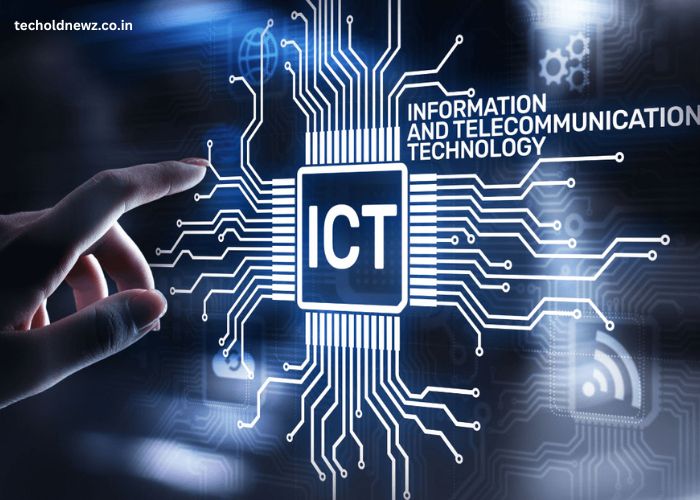The term ICT stands for Information and Communication Technology. It refers to all the technologies used to handle telecommunications, broadcast media, audio-visual processing, and network-based control systems. ICT has become an integral part of our daily lives, impacting sectors like education, healthcare, and business.
From the devices we use to the internet we rely on, ICT powers our modern-day activities. But what does ICT really mean, and how does it affect different areas of our lives? In this guide, we’ll explore its full form, applications, and importance in detail.
Key Points:
- ICT combines communication tools like phones with information technology tools like computers.
- It is widely used in industries, education, and government sectors.
- ICT bridges the gap between technology and communication, making life more efficient.
How Is ICT Defined And What Are Its Components?
ICT refers to all tools and systems used to access, process, store, and share information. It includes both hardware and software technologies that enable communication and data management.
Examples of ICT Tools:
- Hardware: Computers, smartphones, tablets, and servers are all part of ICT hardware.
- Software: Applications like Zoom, Microsoft Teams, and Google Drive that facilitate communication and data sharing.
- Networks: The internet, Wi-Fi, and telecommunications networks are also components of ICT.
Key Components of ICT:
| Component | Example | Purpose |
|---|---|---|
| Hardware | Computers, smartphones | Devices for processing and sharing data |
| Software | Apps, operating systems | Tools for managing and executing tasks |
| Networks | Internet, Wi-Fi | Enables connectivity and communication |
By integrating these components, ICT provides a comprehensive solution for information exchange and communication. Reminder: Understanding these components helps in appreciating the wide applications of ICT.
Why Is ICT Important In Education?
ICT has transformed how students learn and how teachers educate. The traditional methods of education have been supplemented—and in some cases replaced—by digital tools and platforms.
Benefits of ICT in Education:
- Access to Resources: Students can access e-books, online tutorials, and digital libraries anytime.
- Interactive Learning: Tools like smart boards and educational apps make learning engaging.
- Remote Learning: ICT enables virtual classrooms, allowing education to continue during disruptions like pandemics.
Example:
Consider online platforms like Coursera and Khan Academy. These platforms use ICT to deliver education to millions globally, making learning accessible and affordable.
What Role Does ICT Play in Businesses?
In the business world, ICT is a key driver of productivity, efficiency, and innovation. Companies rely on ICT for communication, data management, and customer engagement.
Applications of ICT in Businesses:
- Communication: Tools like email, video conferencing, and instant messaging streamline communication.
- Data Management: Cloud platforms and databases help businesses store and analyze data.
- Customer Interaction: CRM software like Salesforce improves customer engagement and support.
Comparison Chart: ICT in Traditional vs. Modern Businesses
| Aspect | Traditional Business | Modern Business with ICT |
|---|---|---|
| Communication | Letters, face-to-face | Emails, video calls, messaging apps |
| Data Management | Paper records | Cloud storage, databases |
| Customer Interaction | In-person services | Online chat, email, and social media |
ICT has streamlined processes, reduced operational costs, and opened up new markets for businesses worldwide.
How Does ICT Impact Our Daily Lives?
In our personal lives, ICT has revolutionized how we communicate, shop, learn, and entertain ourselves. From smartphones to streaming platforms, ICT influences almost every aspect of daily life.
Examples of ICT in Daily Life:
- Communication: Apps like WhatsApp and FaceTime make staying in touch easier.
- Shopping: E-commerce platforms like Amazon and eBay are ICT-driven innovations.
- Entertainment: Streaming services like Netflix and Spotify rely on ICT for content delivery.
Note:
ICT has made life more convenient, but it also raises concerns about digital privacy and security.
What Are The Challenges of ICT Adoption?
While ICT brings numerous benefits, its adoption is not without challenges. Businesses, schools, and individuals often face obstacles like cost, technical skills, and infrastructure.
Common Challenges:
- High Initial Costs: Setting up ICT systems can be expensive, especially for small businesses.
- Digital Divide: Not everyone has access to high-speed internet or modern devices.
- Cybersecurity Risks: The more connected we are, the higher the risk of data breaches and cyberattacks.
Solution Examples:
- Governments and NGOs providing affordable devices and internet services.
- Companies investing in employee training to upskill their workforce in ICT tools.
Conclusion: Why ICT Is Indispensable
The ICT full form—Information and Communication Technology—represents much more than a term. It’s a transformative force driving progress in education, business, and daily life. From enabling remote learning to automating business operations, ICT has become indispensable. However, addressing its challenges, such as digital inequality and cybersecurity, is essential to maximize its potential.
As technology continues to evolve, ICT will remain at the forefront of innovation and development, shaping a smarter, more connected world.
FAQ’s
- What is the full form of ICT?
ICT stands for Information and Communication Technology. - What are examples of ICT in daily life?
Examples include smartphones, email, video conferencing apps, and e-commerce platforms. - Why is ICT important in education?
ICT makes education accessible, interactive, and flexible through tools like online classes and digital resources. - What are the components of ICT?
ICT includes hardware (computers, phones), software (apps, systems), and networks (internet, Wi-Fi). - What challenges does ICT face?
Common challenges include high setup costs, the digital divide, and cybersecurity risks.


